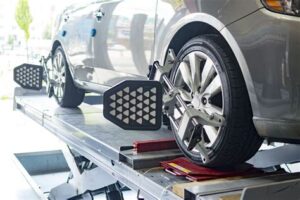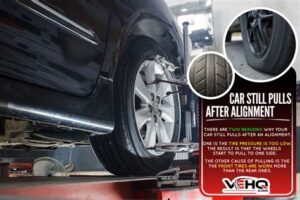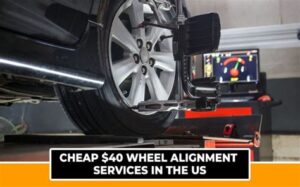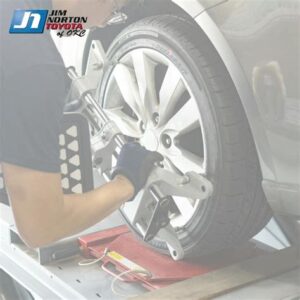Is your vehicle pulling to one side or experiencing uneven tire wear? If so, you may be dealing with recurring alignment issues. Proper wheel alignment is crucial for the optimal performance and safety of your car. Unfortunately, many drivers overlook alignment until problems escalate, leading to complications that can affect not just handling but also fuel efficiency and tire longevity. In this article, we’ll delve into the reasons why your car keeps losing alignment and highlight common signs to watch for. Additionally, we’ll discuss the impact of poor alignment on your vehicle’s performance, actionable steps to take when faced with alignment issues, and preventive measures to safeguard against future problems. Equip yourself with the knowledge to keep your car running smoothly and efficiently on the road.
Understanding Why Your Car Keeps Losing Alignment
Alignment issues can be quite frustrating for vehicle owners, and understanding why your car keeps losing alignment is essential for addressing the problem effectively. There are various factors that contribute to misalignment, and recognizing these can help in both prevention and resolution.
One of the primary causes of alignment loss is hitting potholes or other road imperfections. These sudden impacts can jolt your vehicle’s suspension system, leading to misalignment. Additionally, frequent driving on uneven surfaces can cause gradual misalignment over time.
Another factor to consider is the wear and tear of suspension components. Parts like ball joints, tie rods, and bushings can deteriorate with time and may not maintain their original positioning, contributing to poor alignment. Regular inspections of these components can help catch potential issues early on.
Moreover, improper tire pressure can also lead to alignment problems. When tires are not inflated to the manufacturer’s recommended levels, it can cause uneven wear and affect how your car keeps its alignment. It’s crucial to regularly check tire pressure and invest in a good tire maintenance routine.
Modifications to your suspension system or the addition of heavy loads can impact alignment. If you often load your vehicle with heavy cargo or installed aftermarket suspension parts, this might change how the weight is distributed and affect the alignment.
By understanding these factors, you can take proactive measures to prevent alignment issues, ensuring a smoother and safer driving experience.
Common Signs That Indicate Alignment Issues
Noticing the early signs of alignment issues is essential to maintaining your vehicle’s performance and safety. If your car keeps losing alignment, here are some common indicators to look for:
- Uneven Tire Wear: One of the first signs of alignment problems is uneven tire wear. If you notice that the tread on one side of your tires is wearing down faster than the other, it’s a clear sign that your wheels are not aligned properly.
- Steering Wheel Off-Center: When driving straight, your steering wheel should be centered. If it pulls to one side or feels off-center, this may indicate an alignment issue.
- Vehicle Pulling to One Side: If your car keeps drifting to the left or right while you’re driving, even on a flat road, this is a strong indicator that your alignment is off.
- Vibration in Steering Wheel: Feeling vibrations in the steering wheel, especially at higher speeds, can suggest alignment issues are present, potentially due to imbalanced wheels.
- Strange Noises: Unusual sounds like squeaking or thumping noises while driving can also point towards alignment problems, particularly if they coincide with other symptoms.
If you experience any of these signs, it’s crucial to get your vehicle checked as soon as possible to avoid further damage and ensure safe driving conditions.
How Poor Alignment Affects Your Car’s Performance
When your car keeps losing alignment, it can lead to a range of performance issues that not only affect driving comfort but also compromise safety. Misalignment often causes uneven tire wear, which decreases the lifespan of your tires and can lead to costly replacements. Additionally, when your car is out of alignment, it may cause your steering wheel to vibrate or pull to one side, making it difficult to maintain control.
The following are some specific ways that poor alignment can affect your car’s performance:
- Reduced Fuel Efficiency: A misaligned vehicle consumes more fuel, as the engine works harder to overcome the uneven resistance caused by misaligned wheels. This leads to higher gas expenses over time.
- Compromised Safety: Poor alignment can negatively impact your vehicle’s handling. If your car tends to drift or pull to one side, it can make it challenging to steer, increasing the risk of accidents.
- Increased Wear and Tear: Alongside uneven tire wear, other components like suspensions and bearings can experience added stress. This could lead to premature failures and further alignment issues.
- Uncomfortable Ride: When your car keeps losing alignment, the ride can feel rough. The vehicle may bounce or sway excessively, which can be uncomfortable for passengers and detracts from the overall driving experience.
Addressing alignment issues as soon as they arise is crucial for maintaining your vehicle’s performance and safety. Regular checks and maintenance can help you avoid the adverse effects of poor alignment.
Steps to Take When Your Car Keeps Losing Alignment
If you find that your car keeps losing alignment, it’s essential to take prompt action to avoid further issues. Here are the steps you should follow:
- Identify the Problem: Listen for unusual sounds while driving, especially while turning. If your car pulls to one side or your steering wheel isn’t centered, these are signs of alignment issues.
- Check Tire Pressure: Ensure that your tires are inflated to the manufacturer’s recommended pressure. Incorrect tire pressure can affect alignment.
- Inspect Tires: Look for uneven tire wear patterns. If one side is wearing more quickly than the other, it’s a strong indication that your alignment is off.
- Visit a Professional: Schedule an appointment with a certified mechanic. They can perform an alignment inspection using specialized equipment to diagnose the issue accurately.
- Get an Alignment Adjustment: If the inspection confirms alignment issues, make sure to have the adjustments done professionally. This is crucial if your car keeps losing alignment.
- Keep Records: Document all maintenance and repair work. This information can be useful for understanding recurring issues and providing insight to your mechanic in the future.
- Monitor the Situation: After realignment, keep an eye on your car’s handling characteristics. If you continue to experience problems, return to the mechanic for further analysis.
Taking these steps can help you address alignment issues effectively and ensure your vehicle remains safe and comfortable to drive.
Preventive Measures to Avoid Future Alignment Problems
To ensure your vehicle doesn’t face recurring alignment issues, it’s crucial to adopt some preventive measures. By taking these steps, you can significantly decrease the likelihood of your car keeps losing alignment.
- Regular Tire Maintenance: Ensure that your tires are properly inflated and rotated according to the manufacturer’s recommendations. Uneven tire pressure can lead to misalignment.
- Check Suspension Components: Periodically inspect your suspension system for any signs of wear or damage. Worn-out parts can affect your vehicle’s alignment.
- Avoid Potholes and Obstacles: Be vigilant while driving and try to avoid hitting potholes, curbs, or any debris that can impact the alignment of your car.
- Get Alignment Checks Done Regularly: Schedule regular alignment checks at your trusted mechanic, especially when you notice changes in how your car drives.
- Monitor Wear Patterns on Tires: Keep an eye on your tire tread patterns. Uneven wear can be an indicator of alignment problems.
- Drive Responsibly: Aggressive driving can lead to quicker wear and can affect your vehicle’s overall stability and alignment.
Taking these preventive measures can help ensure that your vehicle stays aligned and performs optimally, preventing the frustration of having your car keeps losing alignment repeatedly.
Frequently Asked Questions
What does it mean if my car keeps losing alignment?
If your car keeps losing alignment, it means that the angles of the wheels are not aligned properly, causing uneven tire wear and affecting vehicle handling.
What are the common signs that indicate a car is out of alignment?
Common signs include the steering wheel being off-center, the car pulling to one side, uneven tire wear, and a vibration while driving.
What causes a car to lose its alignment?
Common causes include hitting potholes or curbs, worn suspension components, or even changes in tire pressure.
How often should I check my car’s alignment?
It’s recommended to check your car’s alignment every 6,000 miles or at the first sign of steering issues or uneven tire wear.
Can driving habits affect alignment?
Yes, aggressive driving, frequent hard braking or acceleration, and driving on rough roads can all contribute to misalignment.
What can I do to prevent my car from losing alignment?
Regular maintenance, avoiding potholes, checking tire pressure, and having your alignment checked periodically can help prevent misalignment.
Is it safe to drive a car that is out of alignment?
It is not safe; driving a car that is out of alignment can lead to poor handling, increased tire wear, and may compromise safety.





